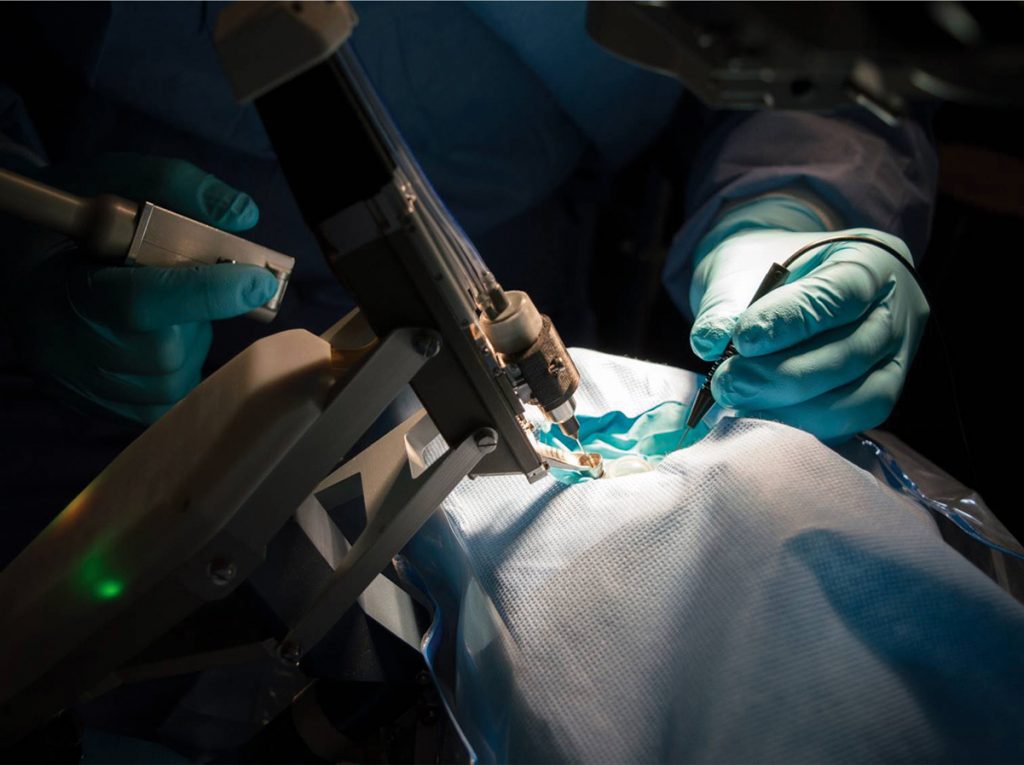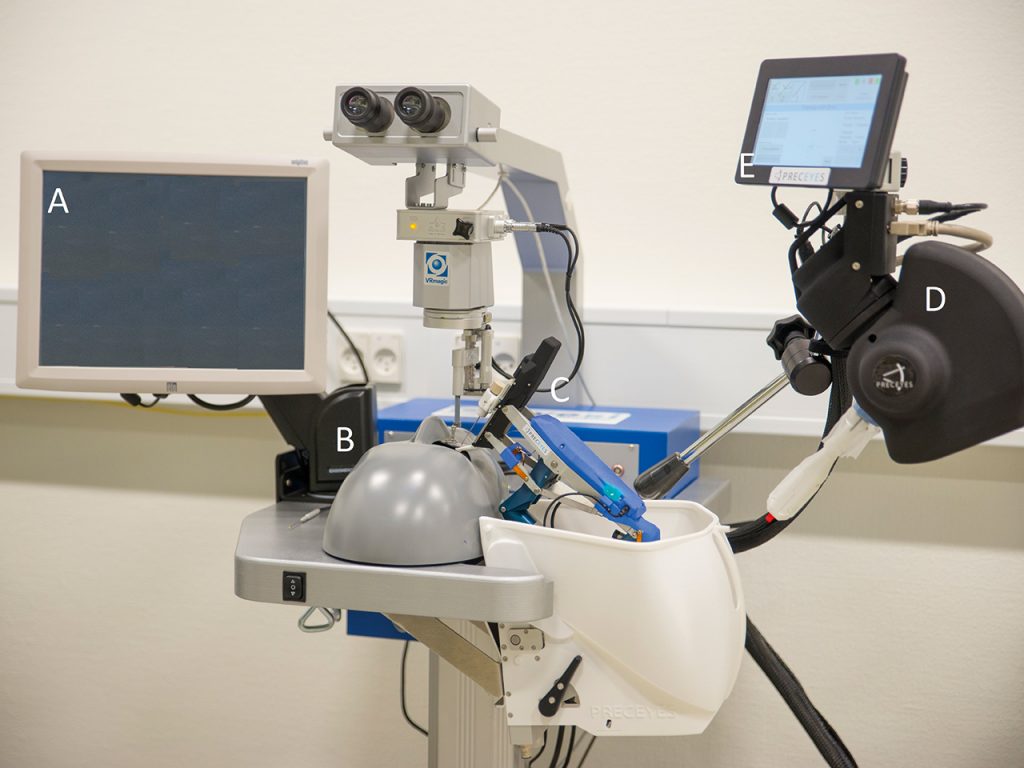Robot-assisted surgery
Robot-assisted vitreoretinal surgery – slower but safer?

Dermot McGrath
Published: Friday, May 1, 2020
[caption id="attachment_19572" align="alignleft" width="1024"] The Preceyes Surgical System: A tele-operated robotically assistive device dedicated to vitreoretinal surgery.
The Preceyes Surgical System: A tele-operated robotically assistive device dedicated to vitreoretinal surgery.
Images courtesy of Preceyes BV[/caption] Mads Forslund Jacobsen MD
Robot-assisted vitreoretinal surgery may hold significant advantages especially for novice surgeons both during training and the early phases of their careers, by improving precision and limiting tissue damage compared to manual surgery, according to a study presented at the 19th EURETINA Congress in Paris.
“Our study suggests that at the cost of additional time, robot-assisted vitreoretinal surgery is more precise for both experienced and novice surgeons, and is associated with less tissue damage for novice surgeons,” said Mads Forslund Jacobsen MD.
“In the future it will be interesting to look at the learning curves for robot-assisted surgery and the impact on patient outcomes in human trials in order to fully shed light on this subject and see if it truly merits a place in everyday clinical application,” he added.
Dr Forslund Jacobsen, Department of Ophthalmology, Rigshospitalet-Glostrup, Copenhagen, Denmark, noted that the very mention of robots triggers certain reflex images in people’s imaginations.
“In science fiction humans have always had an expectation that robots would be part of our future, and the same goes for vitreoretinal surgery. Robotic approaches to VR surgery have long heralded a new age of unprecedented dexterity and precision. However, the discussion on robot-assisted VR surgery is often based on subjective assessment alone. We need hardcore quantifiable data on the possible benefits,” he said.
Therefore, the Copenhagen-based group consisting of Ann Sofia Skou Thomsen MD, PhD, Lars Konge MD, PhD, Prof Morten la Cour MD, DMSc, and Mads Forslund Jacobsen MD, PhD-fellow, decided to use their background in research in simulation based surgical education to conduct this study and generate the needed data.
The randomised controlled crossover study included 10 experienced vitreoretinal surgeons and 10 novice ophthalmic surgeons who were randomised to start with either manual or robot-assisted surgery using the Preceyes robotic system. The surgery was assessed using a virtual-reality based surgical simulator (Eyesi) as a safe and standardised platform, with participants performing ILM peeling, ERM peeling and bimanual manoeuvrability tasks.
[caption id="attachment_19573" align="alignleft" width="1024"]
Mads Forslund Jacobsen MD
Robot-assisted vitreoretinal surgery may hold significant advantages especially for novice surgeons both during training and the early phases of their careers, by improving precision and limiting tissue damage compared to manual surgery, according to a study presented at the 19th EURETINA Congress in Paris.
“Our study suggests that at the cost of additional time, robot-assisted vitreoretinal surgery is more precise for both experienced and novice surgeons, and is associated with less tissue damage for novice surgeons,” said Mads Forslund Jacobsen MD.
“In the future it will be interesting to look at the learning curves for robot-assisted surgery and the impact on patient outcomes in human trials in order to fully shed light on this subject and see if it truly merits a place in everyday clinical application,” he added.
Dr Forslund Jacobsen, Department of Ophthalmology, Rigshospitalet-Glostrup, Copenhagen, Denmark, noted that the very mention of robots triggers certain reflex images in people’s imaginations.
“In science fiction humans have always had an expectation that robots would be part of our future, and the same goes for vitreoretinal surgery. Robotic approaches to VR surgery have long heralded a new age of unprecedented dexterity and precision. However, the discussion on robot-assisted VR surgery is often based on subjective assessment alone. We need hardcore quantifiable data on the possible benefits,” he said.
Therefore, the Copenhagen-based group consisting of Ann Sofia Skou Thomsen MD, PhD, Lars Konge MD, PhD, Prof Morten la Cour MD, DMSc, and Mads Forslund Jacobsen MD, PhD-fellow, decided to use their background in research in simulation based surgical education to conduct this study and generate the needed data.
The randomised controlled crossover study included 10 experienced vitreoretinal surgeons and 10 novice ophthalmic surgeons who were randomised to start with either manual or robot-assisted surgery using the Preceyes robotic system. The surgery was assessed using a virtual-reality based surgical simulator (Eyesi) as a safe and standardised platform, with participants performing ILM peeling, ERM peeling and bimanual manoeuvrability tasks.
[caption id="attachment_19573" align="alignleft" width="1024"] The experimental robot-assisted surgery setup. (A) EyeSi Simulator controls display. (B) EyeSi Simulator phantom head. (C) Robot instrument manipulator. (D) Robot motion controller. (E) Robot controls display[/caption]
The automated metrics of performance supplied by the Eyesi simulator were used as outcome measures and included time with instruments inserted (seconds), instrument movement (mm) and tissue treatment (mm2).
In terms of results, both novices and vitreoretinal surgeons were significantly slower when using robot-assisted surgery as compared to manual surgery. However, the movement outcomes showed that both novices and vitreoretinal surgeons were significantly more precise when performing tasks with less movement of instruments. Novice surgeons were also found to have significantly less tissue damage when using robot-assisted surgery compared to manual surgery, whereas there was no statistically significant difference for experienced VR surgeons.
Mads Forslund Jacobsen: mads.forslund.jacobsen@regionh.dk
The experimental robot-assisted surgery setup. (A) EyeSi Simulator controls display. (B) EyeSi Simulator phantom head. (C) Robot instrument manipulator. (D) Robot motion controller. (E) Robot controls display[/caption]
The automated metrics of performance supplied by the Eyesi simulator were used as outcome measures and included time with instruments inserted (seconds), instrument movement (mm) and tissue treatment (mm2).
In terms of results, both novices and vitreoretinal surgeons were significantly slower when using robot-assisted surgery as compared to manual surgery. However, the movement outcomes showed that both novices and vitreoretinal surgeons were significantly more precise when performing tasks with less movement of instruments. Novice surgeons were also found to have significantly less tissue damage when using robot-assisted surgery compared to manual surgery, whereas there was no statistically significant difference for experienced VR surgeons.
Mads Forslund Jacobsen: mads.forslund.jacobsen@regionh.dk
 The Preceyes Surgical System: A tele-operated robotically assistive device dedicated to vitreoretinal surgery.
The Preceyes Surgical System: A tele-operated robotically assistive device dedicated to vitreoretinal surgery.Images courtesy of Preceyes BV[/caption]
 Mads Forslund Jacobsen MD
Mads Forslund Jacobsen MD The experimental robot-assisted surgery setup. (A) EyeSi Simulator controls display. (B) EyeSi Simulator phantom head. (C) Robot instrument manipulator. (D) Robot motion controller. (E) Robot controls display[/caption]
The automated metrics of performance supplied by the Eyesi simulator were used as outcome measures and included time with instruments inserted (seconds), instrument movement (mm) and tissue treatment (mm2).
In terms of results, both novices and vitreoretinal surgeons were significantly slower when using robot-assisted surgery as compared to manual surgery. However, the movement outcomes showed that both novices and vitreoretinal surgeons were significantly more precise when performing tasks with less movement of instruments. Novice surgeons were also found to have significantly less tissue damage when using robot-assisted surgery compared to manual surgery, whereas there was no statistically significant difference for experienced VR surgeons.
Mads Forslund Jacobsen: mads.forslund.jacobsen@regionh.dk
The experimental robot-assisted surgery setup. (A) EyeSi Simulator controls display. (B) EyeSi Simulator phantom head. (C) Robot instrument manipulator. (D) Robot motion controller. (E) Robot controls display[/caption]
The automated metrics of performance supplied by the Eyesi simulator were used as outcome measures and included time with instruments inserted (seconds), instrument movement (mm) and tissue treatment (mm2).
In terms of results, both novices and vitreoretinal surgeons were significantly slower when using robot-assisted surgery as compared to manual surgery. However, the movement outcomes showed that both novices and vitreoretinal surgeons were significantly more precise when performing tasks with less movement of instruments. Novice surgeons were also found to have significantly less tissue damage when using robot-assisted surgery compared to manual surgery, whereas there was no statistically significant difference for experienced VR surgeons.
Mads Forslund Jacobsen: mads.forslund.jacobsen@regionh.dk
Tags: robot-assisted surgery, vitreoretinal surgery
Latest Articles
Congress Symposium to Highlight Practice Management Issues
Rising into Leadership
Accomplished female ophthalmologists offer advice and encouragement.
Two-Step Procedure Shows Positive Results
Study reveals potentially useful prognostic factors in a large cohort of keratoconus patients.
Programme Committee Provides Backbone of ESCRS Scientific Content
Congress programme reflects commitment to innovation and expertise.
ESCRS IOL Power Calculator Accuracy
All seven formulas are accurate, but two stand out, study finds.
A Second Look at the First IOL Implantation
The traditional hero and villain story might not have a bad guy after all.
MIGS Masterclass to Offer Grand Rounds and Wet Labs in Barcelona
Matching Technologies to Presbyopic Patient Needs
Ever-growing selection of IOLs requires careful screening.
Bringing PROMs into the Intermediate Vision Equation
Quality of life tools need to consider modern treatment options.